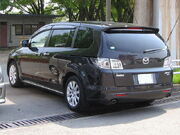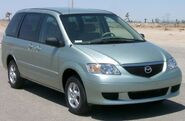 | |
| Manufacturer | Mazda |
|---|---|
| Production |
1989–present 1989–2006 (USA and Europe) |
| Assembly |
Hiroshima, Japan Taiwan USA Thailand Russia[1] |
| Successor |
Mazda5 (For North America and Europe) Mazda CX-9 (For North America and Australia) |
| Class | Minivan |
The Mazda MPV (Multi-Purpose Vehicle) is a minivan manufactured by Mazda. Introduced in 1989 as a rear-wheel drive model with optional selectable four-wheel drive, it was replaced in 2000 with a front-wheel drive-only version. Over one million MPV models had been produced since its introduction.[2]
First generation 1989-1999 (RWD/4WD)[]
 | |
| Also called | Efini MPV (during 1991-1997 in Japan) |
|---|---|
| Production | 1989–1999 |
| Body style(s) |
3-door van (1989-1995) 4-door van (1996-1998) |
| Layout | Front engine, rear-wheel drive / four-wheel drive |
| Platform | Mazda LV platform |
| Engine(s) |
2.6 L G6 I4 (1989-1994) 2.5 L G5 I4 (1995-1998) 3.0 L JE V6 |
| Transmission(s) |
4-speed automatic 5-speed manual |
| Wheelbase | 110.4 in (2804 mm) |
| Length |
1989-1994: 175.8 in (4465 mm) 1995-98: 183.5 in (4661 mm) |
| Width |
71.9 in (1826 mm) 1991-95 4WD: 72.3 in (1836 mm) |
| Height |
1989-1992 & 1995-98 2WD: 68.1 in (1730 mm) 1991-92 4WD: 70.8 in (1798 mm) 1993-94: 66.7 in (1694 mm) 1993-94 4WD: 69.4 in (1763 mm) 1995-97 4WD: 70.8 in (1798 mm) 1998 2WD: 68.9 in (1750 mm) 1998 4WD: 71.5 in (1816 mm) |
| Related | Mazda 929 |
The minivan boom of the 1980s caught the Japanese car makers by surprise. Each maker had its own response: Toyota was first with an adaptation of their mid-engined Van, based on the Japanese TownAce in 1984. Nissan and Mitsubishi quickly followed suit with conversions of cargo vans in 1987. All were small and only offered 4-cylinder engines. This was also the only Mazda MPV generation with a manual transmission. Unlike other minivans, the MPV's parking brake was directly on the floor beside the driver's seat and operated by the hand, when most other minivans had the parking brake in the driver footwell area and operated by the left foot.
The 1989 MPV was designed from the ground-up as a minivan for the American market. It was based on the large rear wheel drive 929's HC. It would be called the LV platform, and equipped the MPV with a V6 engine and optional four-wheel drive. Its selectable 4WD system is not to be confused with permanent "all wheel drive" systems; the MPV can be switched into 4WD with a switch mounted on the column gear selector. A dash mounted switch also allowed the driver to lock the center differential, splitting power equally between the front and rear axles. The 4WD can be engaged and disengaged while moving.
Like the later Honda Odyssey, it featured traditional hinged doors instead of sliding rear doors, though the original MPV only had a single rear door. Because of the MPV's optional 4WD, the Mazda Navajo (sold from 1991–1994) version of the Ford Explorer was only offered as a 2 door. The middle row was available as a bench, allowing seating for 8 when most minivans seated 7.
The van was named to Car and Driver magazine's Ten Best list for 1990 and 1991 and featured as one of their "vehicles for the coming (fuel) crisis". Initial sales were strong as well, but rapidly fell off once other makers introduced all-wheel drive and V6 engines. However, Toyota's 1991 Previa, Nissan's 1993 Quest, and Honda's 1995 Odyssey all featured purpose-built platforms and eroded Mazda's lead.
The MPV received one star out of four in the Australasian New Car Assessment Program crash tests and a "Marginal" rating in the American IIHS crash tests for damage to the occupant compartment and tire intrusion into the driver footwell area.
The van was refreshed in 1996, adding drivers' side rear door, airbag, and moving the parking brake to the footwell. While the I4 engine retired for the United States market, it was replaced with a similar 2.5 L unit for the rest of the world. The '97 and '98 models received a mild refreshing with "all-sport" body cladding and wheel arches, and polished alloy wheels. Mazda discontinued the original MPV after the '99 model year.
Second generation 1999-2006 (FWD/4WD)[]
 | |
| Production | 1999–2006 |
|---|---|
| Body style(s) | 4-door van |
| Layout | FF layout |
| Platform | Mazda LW platform |
| Engine(s) |
2.0 L FS-DE I4 (00-01) 2.5 L GY-DE I4 (99-01) 2.5 L AJ V6 (99-01) 3.0 L AJ V6 (02-05) |
| Transmission(s) | 5-speed 5F31J automatic |
| Wheelbase | 111.8 in (2840 mm) |
| Length |
1999-01: 187.0 in (4750 mm) 2002-03: 187.8 in (4770 mm) 2004-06: 189.5 in (4813 mm) 2004-06 LX-SV: 189.3 in (4808 mm) |
| Width | 72.1 in (1831 mm) |
| Height |
68.7 in (1745 mm) 2004-06 ES: 69.1 in (1755 mm) |
| Related |
Mazda 626 Ford Windstar Kia Carnival |
The MPV was replaced for 1999 using the short wheelbase, front wheel drive LW platform and featuring dual sliding rear doors, a third row seat that could fold and tumble into a floor recess, and dual sliding doors equipped with roll-down power windows. Its bodystyle is somewhat based upon the V platform Ford Windstar.
At introduction, the MPV used the same 170-hp DOHC Ford Duratec unit that powered the Ford Contour and Mercury Mystique and Cougar.[3] DX models featured a two-place middle bench seat. The LX model featured two middle buckets with a feature whereby the passenger side seat could slide sideways (marketed as "side by slide"), power windows and locks, heated power mirrors, privacy glass, and antilock brakes. The ES model added leather seating surfaces, wood tone interior trim, side impact air bags on the front seats, bigger wheels, and dual zone front and rear air conditioners.
In model year 2001, all models added child-safety seat tether anchors. An optional GFX sport appearance package was made available for LX and ES models, which included fog lights and aero body add-ons. The 2001 model year ran long, extending into early 2002 in anticipation of the 2002 refresh.
In model year 2002, the MPV received Mazda's AJ 3.0 L V6, a 5-speed automatic transmission producing 200 hp (149 kW) and 200 lb·ft (270 N·m) of torque, a new grille featuring a single chrome bar at the top, power sliding side doors, revised suspension settings, and 17-inch alloy wheels.
In model year 2003, power operation of the side doors was made optional on the LX and ES. A base LX-SV model was added midway into the model year.
In model year 2004, the MPV received a mild exterior and interior makeover. The exterior featured new headlights and Altezza style clear taillights. Interior changes included a new steering wheel, gauge surrounds, and a spring assist to ease folding the third row seat into the floor. The LX Sport package added a customized look with alloy wheels, body side skirts, enhanced tail lights, anti-lock brakes, an air dam under the bumper, and an optional rear-mounted spoiler. The ES model added leather seats, rear air conditioner, power sliding doors, and a choice of moonroof or roof-mounted DVD player. No LX-SV model was offered.
In model year 2005, dual zone air conditioning became an optional feature on the LX (it had been standard on the LX in 2004).
In model year 2006, a base LX-SV model was again offered alongside the LX and ES models.
The MPV was discontinued in both Europe and North America after model year 2006. The MPV was also replaced in North America and Australia by the full-size Mazda CX-9 crossover SUV. Australian models were available with 3 seats in the 2nd row, and two seats in the 3rd row instead of a folding third row.
Engines:
- 1999-2001 2.0 L FS-DE I4 (non-US)
- 1999-2001 2.5 L GY-DE I4 (non-US)
- 1999-2001 2.5 L AJ V6
- 2002-2006 3.0 L AJ V6
- 2005–present 2.3 L MZR 2.3 Direct Injecition Spark Ignition (DISI) Turbocharged I4 (non-US)
For 2006 the base MSRP for MPV models was LX-SV ($22,115), LX:(22,950), and ES ($28,515).
The Mazda MPV earned an "Acceptable" rating in the IIHS offset frontal crash test in 2000 for fair structural performance and very high forces on the dummy's right foot. In 2005, it earned a "Poor" rating in the side-impact crash test without the optional side airbags, indicating that high injuries to the driver and rear occupant are possible.
Third generation 2006- (FWD/4WD)[]
 | |
| Also called | Mazda8 |
|---|---|
| Production | 2006–present |
| Body style(s) | 4-door van |
| Layout | FF layout |
| Platform | Mazda LY platform |
| Engine(s) |
2.3 L L3-VE I4 2.3 L L3-VDT turbo I4 |
| Transmission(s) | 4/5/6-speed automatic |
| Wheelbase | 2,950 mm (116.1 in) |
| Length |
2007: 4,868 mm (191.7 in) 2008-present: 4,860 mm (191.3 in) |
| Width | 1,850 mm (72.8 in) |
| Height | 1,685 mm (66.3 in) |
| Related | Mazda6 |
On February 2, 2006, the third generation Mazda MPV went on sale in Japan.[4] It is powered by either a 4 cylinder MZR 2.3 naturally aspirated engine or 4 cylinder MZR 2.3 Direct Injection Spark Ignition (DISI) turbo engine. The 2nd row reclining seats feature an unusual retracting footrest feature. The gear shift was moved from the steering column to the center console, much like most other minivans by Japanese automakers today.
The third generation MPV is currently available only in Japan, Hong Kong, Macau, Thailand, Russia and Malaysia.[5] It is known as Mazda8 in Hong Kong, Macau, and Malaysia. The 4WD and Turbo models are available only in the domestic (Japanese) market. All export models (known as Mazda8) are NA FWD only.
In 2008, a facelifted version was introduced. External modifications include new front bumper with new fog-lights. A 5-Speed Automatic transaxle replaced the 4-speed in NA FWD models. 6-Speed Automatics remained in Turbo and 4WD models.
Turbo models were discontinued in 2010. A Malaysian version was introduced in 2010, the fourth market the third generation Mazda MPV is sold.

2009 Mazda MPV rear view (Japan spec)
References[]
| This page uses some content from Wikipedia. The original article was at Mazda MPV. The list of authors can be seen in the page history. As with Tractor & Construction Plant Wiki, the text of Wikipedia is available under the Creative Commons by Attribution License and/or GNU Free Documentation License. Please check page history for when the original article was copied to Wikia |
- ↑ "Facilities | Ford Motor Company Newsroom". Media.ford.com. Retrieved on 2010-07-27.
- ↑ "Mazda MPV Production Reaches One Million Units". Webwire.com. Retrieved on 2009-04-11.
- ↑ "Used Vehicle Review: Mazda MPV, 2000-2006". Canadian Driver, Chris Chase, January 2010.
- ↑ "The innovative Mazda MPV minivan is a "next-generation people mover" with the soul of a sports car". Mazda Press Release. Retrieved on June 4, 2007.
- ↑ "to Sell New MPV in Hong Kong | News Releases". MAZDA (2006-03-22). Retrieved on 2009-04-11.
External links[]
- Mazda Japan new MPV product website
- YahooAutos-2006 Mazda MPV
- AutomobileMagazine-2005 Mazda MPV (review)
- Hong Kong Mazda8 product website
- MPV Club
- Mazda announces 1 million built, introduces gen3 and planned turbo version for Japan
| « previous — Mazda road car timeline, 1990s–present | ||||||||||||||||||||||
|---|---|---|---|---|---|---|---|---|---|---|---|---|---|---|---|---|---|---|---|---|---|---|
| Type | 1990s | 2000s | 2010s | |||||||||||||||||||
| 0 | 1 | 2 | 3 | 4 | 5 | 6 | 7 | 8 | 9 | 0 | 1 | 2 | 3 | 4 | 5 | 6 | 7 | 8 | 9 | 0 | 1 | |
| Kei car | Carol | Carol | Carol | Carol | Carol | |||||||||||||||||
| AZ-Wagon | AZ-Wagon | AZ-Wagon | AZ-Wagon | |||||||||||||||||||
| AZ-Offroad | ||||||||||||||||||||||
| Spiano | ||||||||||||||||||||||
| Scrum | Scrum/Scrum Wagon | Scrum/Scrum Wagon | ||||||||||||||||||||
| Subcompact | Revue/121 | Demio/121 | Demio/Mazda2 | Demio/Mazda2 | ||||||||||||||||||
| Verisa | ||||||||||||||||||||||
| Compact | Familia/323/Protegé | Familia/323/Protegé | Familia/323/Protegé | Axela/Mazda3 | Axela/Mazda3 | |||||||||||||||||
| Familia Van | Familia Van | Familia Van | ||||||||||||||||||||
| Mid-size | Capella/626 | Capella | Capella/626 | Atenza/Mazda6 | Atenza/Mazda6 | |||||||||||||||||
| Cronos/626/Xedos 6/Eunos 500 | ||||||||||||||||||||||
| Eunos 800/Xedos 9/Millenia | Mazda6 (N.America) | |||||||||||||||||||||
| Full-size | Sentia/929/Efini MS-8 | Sentia | ||||||||||||||||||||
| Sports car | AZ-1 | |||||||||||||||||||||
| MX-3 Precidia | ||||||||||||||||||||||
| Roadster/MX-5/Miata | Roadster/MX-5/Miata | Roadster/MX-5 | ||||||||||||||||||||
| MX-6/Mystère | MX-6/Mystère/Efini MS-6 | |||||||||||||||||||||
| RX-7 | Efini RX-7/RX-7 | |||||||||||||||||||||
| Cosmo | RX-8 | |||||||||||||||||||||
| Minivan | Premacy | Premacy/Mazda5 | Premacy/ Mazda5 | |||||||||||||||||||
| Bongo Friendee | Biante | |||||||||||||||||||||
| Efini MPV/MPV | MPV | MPV/Mazda8 | ||||||||||||||||||||
| Crossover | CX-7 | |||||||||||||||||||||
| CX-9 | ||||||||||||||||||||||
| SUV | Navajo | Tribute | Tribute | |||||||||||||||||||
| Pickup | B-Series | B-Series | B-Series | BT-50 | BT-50 | |||||||||||||||||
| Van | Bongo | Bongo | ||||||||||||||||||||
| Mazda automobile timeline, North American market, 1980s–present | ||||||||||||||||||||||||||||||||
|---|---|---|---|---|---|---|---|---|---|---|---|---|---|---|---|---|---|---|---|---|---|---|---|---|---|---|---|---|---|---|---|---|
| Type | 1980s | 1990s | 2000s | 2010s | ||||||||||||||||||||||||||||
| Model year | 0 | 1 | 2 | 3 | 4 | 5 | 6 | 7 | 8 | 9 | 0 | 1 | 2 | 3 | 4 | 5 | 6 | 7 | 8 | 9 | 0 | 1 | 2 | 3 | 4 | 5 | 6 | 7 | 8 | 9 | 0 | 1 |
| Subcompact | GLC | GLC | Mazda2 | |||||||||||||||||||||||||||||
| 323 | 323/Protegé | |||||||||||||||||||||||||||||||
| Compact | Protegé | Protegé | Mazda3 | Mazda3 | ||||||||||||||||||||||||||||
| 626 | 626 | 626 | ||||||||||||||||||||||||||||||
| Mid-size | 626 | 626 | Mazda6 | Mazda6 | ||||||||||||||||||||||||||||
| Millenia | ||||||||||||||||||||||||||||||||
| Full-size | 929 | 929 | ||||||||||||||||||||||||||||||
| Sport compact | MX-3 | |||||||||||||||||||||||||||||||
| MX-6 | MX-6 | |||||||||||||||||||||||||||||||
| Sports | MX-5 Miata | MX-5 Miata | MX-5 | |||||||||||||||||||||||||||||
| RX-7 | RX-7 | RX-7 | RX-8 | |||||||||||||||||||||||||||||
| Minivan | Mazda5 | |||||||||||||||||||||||||||||||
| MPV | MPV | |||||||||||||||||||||||||||||||
| Mid-size crossover | CX-7 | |||||||||||||||||||||||||||||||
| Full-size crossover | CX-9 | |||||||||||||||||||||||||||||||
| SUV | Navajo | Tribute | Tribute | |||||||||||||||||||||||||||||
| Pickup | B-Series | B-Series | B-Series | B-Series | ||||||||||||||||||||||||||||





